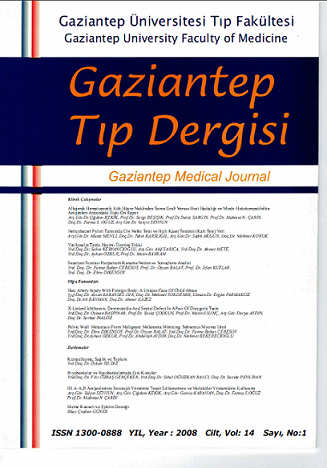Undetected HLA-A,B Antigens By Serological Method And Application Of Molecular MethodsUndetected HLA-A,B Antigens By Serological Method And Application Of Molecular Methods
DOI:
https://doi.org/10.58600/eurjther.2008-14-1-1357-archKeywords:
HLA, serological method, molecular method, transplantationAbstract
İnsan lökosit uyumluluğu böbrek nakillerinde çok önemli bir etkiye sahip olduğundan ve başarılı kemik iliği nakilleri için donör ve alıcı arasında tam uyumlu HLA uyumluluğuna ihtiyaç vardır. HLA sisteminin böbrek ve kemik iliği nakillerinde önemli rol oynadığı açıkça görülmektedir. Bu nedenle, bu antijenlerin doğru ve güvenilir bir şekilde tanımlanması çok önemlidir. EFI akredite laboratuvarlarımızda HLA-A,-B tiplendirmesi için CDC testi yapıyoruz. Homozigotluk veya belirsiz bir antijenin saptanması durumunda, CDC'ye ek olarak moleküler yöntemler de uygulanır. Çalışmamızın amacı, CDC'ye ek olarak moleküler tiplemeye ihtiyaç duyulan olgulara ilişkin iki yöntemin karşılaştırmalı sonuçlarını ortaya koymak ve CDC ile tanımlanamayan ancak moleküler tipleme ile tanımlanamayan antijenleri listelemektir. Çalışma grubunu kronik böbrek yetmezliği olan hastalar (n=1567), hematolojik maligniteler (n=646) ve donörlerinden (n=646) oluşan 275 birey oluşturdu. Örnekler HLA-A,-B için CDC ve PCR-SSP/SSO yöntemleri ile yazıldı. Çalışma grubu tek HLA-A ve/veya -B ve belirsiz HLA-A ve/veya -B olguları olarak 5 gruba ayrıldı. Moleküler yöntemlerle 2138 test yapıldı. CDC testi ile moleküler yöntemler arasındaki uyum HLA-A için %8.8, HLA-B için %14.2 idi. CDC ile moleküler yöntemler dışında tanımlanamayan en sık antijenler HLA-A32, B15 (%7.3, %15.8) idi. Moleküler doku tipleme yöntemlerinin en azından özellikle hasta örneklerine uygulanmasının transplantasyon başarısını artıracağına inanıyoruz.
Metrics
References
Abbas AK. Celluler and molecular immunology. (3th ed).WB Saunders Company. 1997;(2):16-33.
Thiru S, Waldman H. Pathology and Immunology of transplantation and Rejection. Blackwell Science Ltd. 2001;(1):1-21.
Titiz İ. Renal Transplantasyona Pratik Yaklaşım. (İkinci Baskı). 2004;(1):11-100.
Opelz G, Wujciak T, Dohler B. Is HLA matching worth the effort? Transplant Proc. 1999;31:717-720.
Opelz G, Wujciak T, Döhler B, Scherer S, Mytilineos J. HLA compatibility and organ transplant survival. Collaborative Transplant Study. Rev Immunogenet. 1999;1(3):334-42.
Opelz G, Döhler B. Effect of human leukocyte antigen compatibility on kidney graft survival: comparative analysis of two decades. Transplantation. 2007;84(2):137-43.
Aydingoz SE, Takemoto SK, Pinsky BW, Salvalaggio PR, Lentine KL, Willoughby L, et al. The impact of human leukocyte antigen matching on transplant complications and immunosuppression dosage. Hum Immunol. 2007;68(6):491- 9.
Terasaki PI, McClelland JD. Microdroplet assay of human serum cytotoxins. Nature. 1964;204:998-1000.
Gustincich S, Manfioletti G, Del Sal G, Schneider C, Carninci P. A fast method for high-quality genomic DNA extraction from whole human blood. Biotechniques. 1991;11(3):298-300.
Olerup O, Zetterquist H. HLA-DR typing by PCR amplification with sequence-specific primers (PCR-SSP) in 2 hours: an alternative to serological DR typing in clinical practice including donor-recipient matching in cadaveric transplantation. Tissue Antigens. 1992;39(5):225-35.
Buyse I, Decorte R, Baens M, Cuppens H, Semana G, Emonds MP, et al. Rapid DNA typing of class II HLA antigens using the polymerase chain reaction and reverse dot blot hybridization. Tissue Antigens. 1993;41(1):1-14.
Tan J, Tang X, Xie T. Comparison of HLA class I typing by serology with DNA typing in a Chinese population. Transplant Proc. 2000;32(7):1859-61.
Mytilineos J, Lempert M, Scherer S, Schwarz V, Opelz G. Comparison of serological and DNA PCR-SSP typing results for HLA-A and HLA-B in 421 Black individuals: a Collaborative Transplant Study report. Hum Immunol. 1998;59(8):512-7.
Kulcsarova E, Kralovicova J, Parnicka Z, Ferencik S, Buc M. Comparison of the results of HLA typing using serologic and molecular genetics methods. Bratisl Lek Listy. 2000;101(3):134-7.
Li D, Liu H, Yu Y, Xi B. Comparison of serological and DNA typings for HLA-AB of cord blood samples. Zhonghua Xue Ye Xue Za Zhi. 2000;21(8):397-9.
Laux G, Opelz G. Immunological relevance of CREG matching in cadaver kidney transplantation. Transplantation. 2004;78(3):442-6.
Torio A, Moya-Quiles MR, Muro M, Montes-Ares O, Ontafion J, Minguela A, et al. Discrepancies in HLA-C typing in transplantation: comparison of PCR-SSP and serology results. Transplant Proc. 2002;34(1):419-20.
Ferraz AS, Saber LS, Voltarelli JC, Mytilineos J, Opelz G, Donadi EA. Comparative study of HLA-DR typing by serology and sequence-specific primer analysis in a genetically highly diverse population of kidney transplant recipients. Transplant Proc. 2002;34(2):463-5.
Mytilineos J, Christ U, Lempert M, Opelz G. Comparison of typing results by serology and polymerase chain reaction with sequence-specific primers for HLA-Cw in 650 individuals. Tissue Antigens. 1997;50(4):395-400.
Downloads
Published
How to Cite
Issue
Section
License
Copyright (c) 2023 European Journal of Therapeutics

This work is licensed under a Creative Commons Attribution-NonCommercial 4.0 International License.
The content of this journal is licensed under a Creative Commons Attribution-NonCommercial 4.0 International License.


















